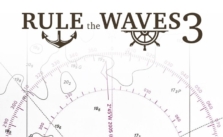Rule the Waves 3: Hits, Damage and Fires

Hits and Armor Types in Rule the Waves 3:
Hits against various types of armor on your ship will be recorded in the event log. An asterisk (*) next to the hit signifies that the hit has penetrated the armor. Non-penetrating hits will cause minimal or no damage. Armor types are categorized as follows:
Belt (B): This is the main belt armor of the ship.
Upper Belt (BU): This armor protects the upper part of the hull or the upper strakes of belt armor.
Belt Extended (BE): This armor protects the ends of the ship, as well as the boiler uptakes.
Deck (D): This is the main armor deck of the ship.
Deck Extended (DE): This corresponds to the belt extended (BE) above.
Turret (T): This refers to the main gun turret armor.
Turret Top (TT): This is the roof of the main gun turret.
Secondary Gun Armor (SEC): Armor for secondary guns.
Conning Tower (CT): This is the armor of the conning tower.
The range at which your ship is hit will affect whether the belt or deck armor takes the impact, with deck hits more frequent at longer ranges.
Damage Types:
Even non-penetrating hits can destroy or disable main turrets. Engine room hits usually affect the speed of the ship, while waterline hits or torpedo hits can lead to progressive flooding. The chance of successful damage control, which works to limit flooding, increases if the ship is moving at a lower speed.
Sinking State:
A sinking ship will not disappear instantly. It will remain in a sinking state for several hours and can still be targeted by enemy fire. It replicates the decision-making conditions real admirals faced, as it’s hard to tell whether an enemy ship is sinking or just severely damaged.
Rescue Missions:
When a ship sinks and the enemy is at a safe distance, you have the opportunity to initiate a rescue mission for survivors. Rescuing survivors earns you victory points, regardless of their original allegiance.
Hit Locations:
Hits can occur in various parts of the ship, with different effects:
Near Miss: This may cause flotation damage to unarmored ships or disable guns on light ships.
Turret: A hit here can disable or destroy the turret. A penetrating hit may cause a catastrophic flash fire.
Hull: Hits here cause flotation damage.
Engine Room: Hits here affect the speed and can cause flotation damage.
Superstructure: This causes superstructure damage and can damage unarmored secondary or tertiary guns.
Torpedo Tubes: Hits here can disable torpedo tubes and potentially cause an explosion or severe flooding.
Missile Launchers: Hits here can disable the launchers and potentially cause them to explode, leading to further damage.
Secondary Battery: Hits can destroy secondary guns.
Critical Hits: These can cause severe damage, including to the rudder, machinery, magazines, fire control, bridge, electrical system, and waterline. They may also trigger an explosion of any carried mines.
Fires:
Fires can break out as your ship takes damage, with higher chances for HE shell hits. The risk varies by ship type, with carriers, TR, AMC, AV, and B being the most susceptible. Fires initially cause minimal damage but can spread or be contained by damage control.
Large fires can damage superstructure points and affect other damage control operations, rate of fire, or even stop the ship’s firing as crews focus on combating the fire. A ship on fire is easier to spot at night and will produce more smoke. Fire risks decrease as the game progresses and as you research better damage control methods.


